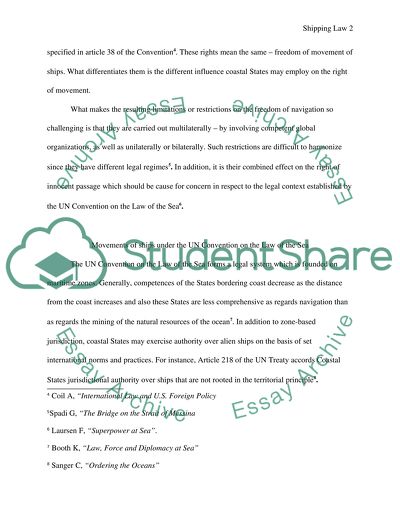Cite this document
(Freedom of Navigation, Measures Limiting the Freedom of Navigation, Tr Case Study, n.d.)
Freedom of Navigation, Measures Limiting the Freedom of Navigation, Tr Case Study. Retrieved from https://studentshare.org/law/1665559-shipping-law-coursework-one-explain-and-critically-evaluate-the-concept-of-freedom-of-navigation-how-does-the-law-of-the-sea-draw-a-balance-between-a-providing-and-facilitating-free-innocent-passageand-b-imposing-restraints-on-such-navigation
Freedom of Navigation, Measures Limiting the Freedom of Navigation, Tr Case Study. Retrieved from https://studentshare.org/law/1665559-shipping-law-coursework-one-explain-and-critically-evaluate-the-concept-of-freedom-of-navigation-how-does-the-law-of-the-sea-draw-a-balance-between-a-providing-and-facilitating-free-innocent-passageand-b-imposing-restraints-on-such-navigation
(Freedom of Navigation, Measures Limiting the Freedom of Navigation, Tr Case Study)
Freedom of Navigation, Measures Limiting the Freedom of Navigation, Tr Case Study. https://studentshare.org/law/1665559-shipping-law-coursework-one-explain-and-critically-evaluate-the-concept-of-freedom-of-navigation-how-does-the-law-of-the-sea-draw-a-balance-between-a-providing-and-facilitating-free-innocent-passageand-b-imposing-restraints-on-such-navigation.
Freedom of Navigation, Measures Limiting the Freedom of Navigation, Tr Case Study. https://studentshare.org/law/1665559-shipping-law-coursework-one-explain-and-critically-evaluate-the-concept-of-freedom-of-navigation-how-does-the-law-of-the-sea-draw-a-balance-between-a-providing-and-facilitating-free-innocent-passageand-b-imposing-restraints-on-such-navigation.
“Freedom of Navigation, Measures Limiting the Freedom of Navigation, Tr Case Study”. https://studentshare.org/law/1665559-shipping-law-coursework-one-explain-and-critically-evaluate-the-concept-of-freedom-of-navigation-how-does-the-law-of-the-sea-draw-a-balance-between-a-providing-and-facilitating-free-innocent-passageand-b-imposing-restraints-on-such-navigation.


